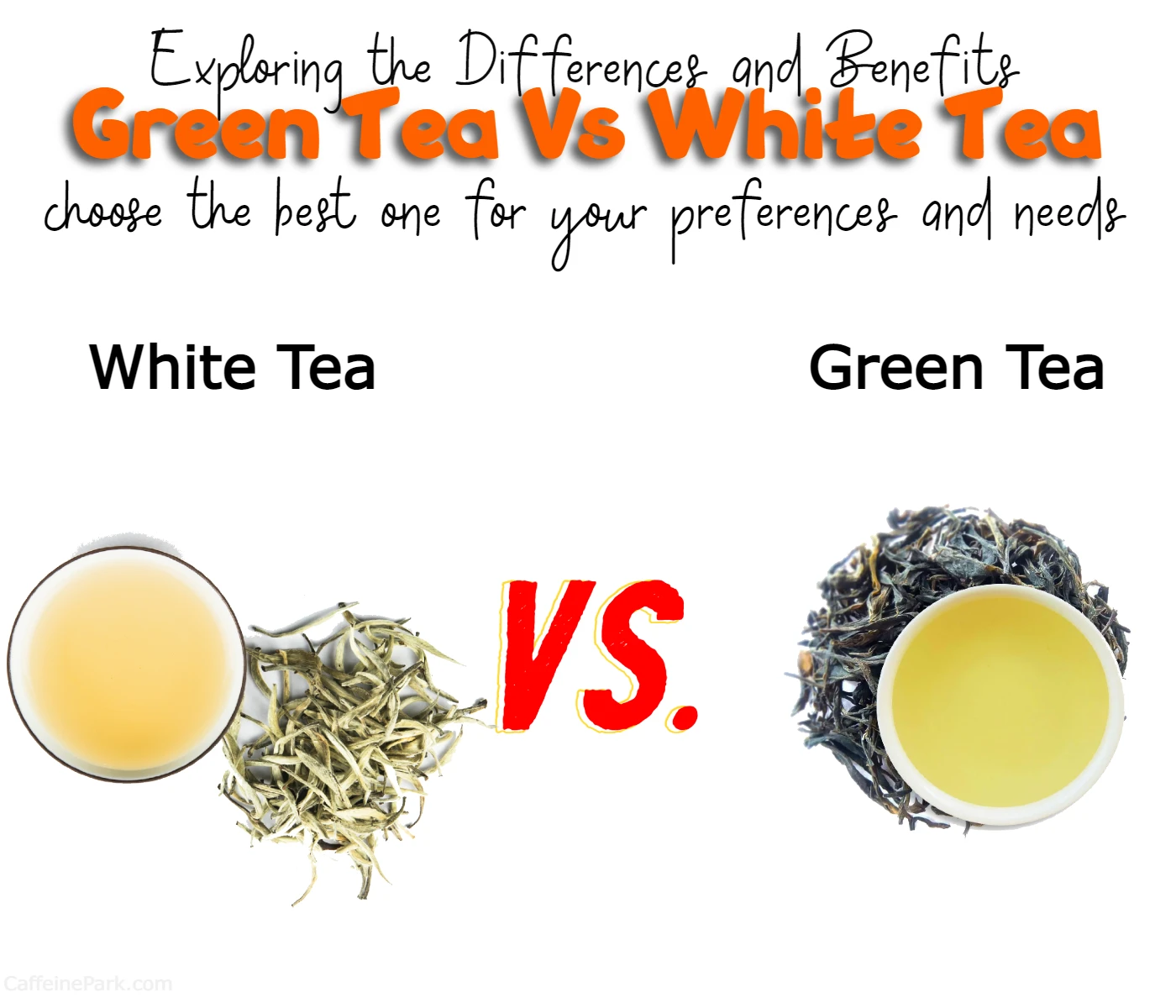
Hello tea lovers! Are you wondering about the differences between white tea and green tea? Look no further! In this blog post, we will explore the differences between these two popular types of tea and their respective benefits.
While both white tea and green tea are made from the same plant, Camellia sinensis, they are processed differently, resulting in unique flavors and health benefits. White tea is minimally processed, with young leaves and buds dried in the sun or temperature-controlled rooms without rolling or oxidizing. This preserves its delicate flavor and aroma, resulting in a light golden color and smooth texture. Green tea, on the other hand, undergoes a heating process called “kill green” after harvesting, stopping the oxidation process and preserving its natural color, flavor, and aroma. This results in a more pronounced flavor with a slightly bitter, vegetal taste and pale green color.
So, which one is better? That depends on your personal preference! White tea has a milder flavor and lower caffeine content, making it a good choice for those sensitive to caffeine. It’s also rich in antioxidants and may help improve cardiovascular health. Green tea has a stronger flavor and more caffeine, making it a better option for those who enjoy a stronger taste. It’s also rich in antioxidants, particularly catechins, and may help improve brain function and lower blood pressure. Read on to discover more about the unique benefits of each type of tea!
Here’s a quick chart outlining the main differences between green tea and white tea:
| Green Tea | White Tea | |
|---|---|---|
| Processing | Heated after harvest | Minimally processed |
| Flavor | Strong, slightly bitter | Mild, delicate |
| Caffeine Content | Moderate to high | Low |
| Color | Pale green | Light golden |
| Health Benefits | Rich in catechins, may improve brain function and lower blood pressure | Rich in antioxidants, may improve cardiovascular health |
Remember, both green tea and white tea offer health benefits and delicious flavor profiles, so choose the one that suits your taste and preferences best!
Difference Between Green Tea and White Tea
Two of the most popular types are white tea and green tea. While both teas are made from the same plant, Camellia sinensis, they have different processing methods and offer unique flavors and health benefits. In this article, we’ll explore the differences between white tea and green tea and their respective benefits.
What is White Tea?
White tea is a minimally processed tea that is made from the young leaves and buds of the Camellia sinensis plant. The leaves are plucked before they are fully open and are then withered and dried in the sun or in a temperature-controlled room. Unlike other types of tea, white tea is not oxidized or rolled, which helps to preserve its delicate flavor and aroma.
Flavor Profile
White tea has a delicate, subtle flavor that is often described as sweet and slightly floral. It has a light golden color and a smooth, silky texture. Because white tea is minimally processed, it has a lower caffeine content than other types of tea, making it a good option for those who are sensitive to caffeine.
Health Benefits
White tea is rich in antioxidants, which can help to protect your cells from damage caused by free radicals. It also contains polyphenols, which have been shown to have anti-inflammatory and anti-cancer properties. Additionally, white tea may help to improve cardiovascular health by reducing cholesterol levels and improving blood vessel function.
What is Green Tea?
Green tea is also made from the leaves and buds of the Camellia sinensis plant, but it undergoes a different processing method than white tea. After the leaves are harvested, they are quickly heated to stop the oxidation process. This heating process, known as “kill green,” helps to preserve the natural color, flavor, and aroma of the tea.
Flavor Profile
Green tea has a more pronounced flavor than white tea, with a slightly bitter, vegetal taste. It can also have a grassy or nutty flavor, depending on the type of green tea you choose. Green tea has a pale green color and a slightly astringent texture.
Health Benefits
Like white tea, green tea is rich in antioxidants, particularly a type of antioxidant called catechins. These compounds have been shown to have anti-inflammatory and anti-cancer properties, as well as the ability to lower blood pressure and improve cholesterol levels. Additionally, green tea has been shown to help improve brain function and reduce the risk of developing neurological disorders like Alzheimer’s and Parkinson’s.
White Tea vs Green Tea: Which One is Better?
When it comes to choosing between white tea and green tea, there is no clear winner. Both teas offer unique flavors and health benefits, so it really comes down to personal preference. If you prefer a milder flavor and are looking for a tea with a lower caffeine content, white tea may be a good choice for you. On the other hand, if you enjoy a stronger flavor and are looking for a tea with more caffeine, green tea may be a better option.
It’s also worth noting that the health benefits of both white tea and green tea are dose-dependent, meaning that you need to drink a certain amount of tea to see the benefits. To get the most out of your tea, aim to drink at least three cups per day.
Caffeine Content in Green Tea and White Tea
Green tea and white tea both naturally contain caffeine, although the amount can vary depending on the specific type of tea and brewing method used.
On average, green tea contains around 20-50 milligrams of caffeine per 8-ounce cup, while white tea contains around 15-30 milligrams of caffeine per 8-ounce cup. This makes white tea a good choice for those who are sensitive to caffeine or who prefer milder tea.
It’s worth noting that the caffeine content of tea can also be influenced by factors such as the quality of the tea leaves, how they are processed, and how long the tea is brewed. For example, steeping green tea for a longer period of time or using hotter water can increase the caffeine content.
If you’re looking to reduce your caffeine intake, you can try brewing your green tea or white tea for a shorter period of time or using cooler water to help reduce the caffeine content. Additionally, there are decaffeinated versions of both green tea and white tea available for those who want to enjoy the health benefits and flavor of tea without caffeine.
Other Types of Tea
While white tea and green tea are both popular options, there are many other types of tea available, each with its own unique flavor and health benefits. Here are a few other types of tea you may want to try:
Black tea: Black tea is a fully oxidized tea that has a strong, bold flavor. It is often enjoyed with milk and sugar Oolong tea: Oolong tea is a partially oxidized tea that falls somewhere between green tea and black tea. It has a complex flavor profile and can have notes of fruit, flowers, and honey.
Herbal tea: Herbal tea is not technically tea since it is not made from the Camellia sinensis plant. Instead, it is made from a variety of herbs, fruits, and flowers. Herbal teas can be caffeine-free and offer a range of health benefits depending on the ingredients.
Pu-erh tea: Pu-erh tea is a fermented tea that is aged for several years. It has a unique flavor profile that is often described as earthy or woody. Pu-erh tea is believed to aid in digestion and can also help to lower cholesterol levels.
Conclusion
White tea and green tea are two popular types of tea that offer unique flavors and health benefits. While they come from the same plant, their different processing methods result in distinct flavor profiles. Ultimately, the choice between white tea and green tea comes down to personal preference. Whichever one you choose, be sure to drink it regularly to reap the health benefits. And don’t forget to explore other types of tea as well, as there are many delicious and healthy options to choose from.
Facts
Here are some interesting facts about green tea and white tea:
- Both green tea and white tea come from the same plant, Camellia sinensis, which is native to China.
- White tea gets its name from the fine white hairs on the young leaves and buds used to make the tea.
- Green tea has been used in traditional Chinese medicine for centuries to treat a variety of ailments, from headaches to depression.
- White tea is the least processed of all the teas and is made from the youngest leaves and buds of the tea plant.
- Green tea is a natural source of caffeine, which can help improve mental alertness and focus.
- White tea contains a higher concentration of antioxidants than green tea, which can help protect against free radicals that cause cellular damage.
- Both green tea and white tea are believed to have anti-inflammatory properties, which can help reduce the risk of chronic diseases such as heart disease and cancer.
- In Japan, green tea is often served with meals as a way to aid digestion and promote overall health.
- White tea has a subtle, delicate flavor that is often described as sweet and floral, while green tea has a slightly bitter, vegetal taste.
- Both green tea and white tea can be enjoyed hot or cold and can be brewed in a variety of ways to suit your taste preferences.
FAQs
Both green tea and white tea offer unique health benefits, so it ultimately depends on your individual needs and preferences. Green tea is rich in catechins, which may help improve brain function and lower blood pressure, while white tea is high in antioxidants that can improve cardiovascular health.
Green tea generally has more caffeine than white tea, although the exact amount can vary depending on the specific type and brewing method.
Green tea has a stronger, more bitter taste than white tea, which has a milder, delicate flavor.
Yes, you can certainly enjoy a blend of green tea and white tea for a unique flavor profile and potential health benefits from both types.
To brew green tea, heat water to about 175°F and steep the tea for 1-3 minutes, depending on your preference. To brew white tea, heat water to about 160°F and steep the tea for 1-2 minutes. It’s always best to follow the specific brewing instructions on your tea packaging for the best results.
While it’s not common to add milk or sugar to green tea or white tea, you can certainly experiment with different flavor combinations to suit your taste preferences. Some people enjoy adding honey or lemon to their tea for added sweetness or tartness.
Read More:





